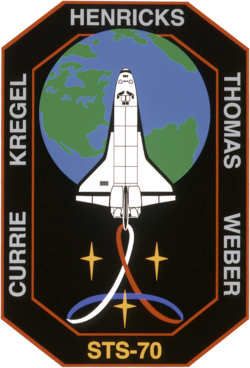STS-70
| STS-70 | |||||
 | |||||
| Uppdrag | 70 | ||||
|---|---|---|---|---|---|
| Rymdfärja | Discovery (21)[1] | ||||
| NSSDC-ID | 1995-035A[2] | ||||
| Färdens tid | 8 dagar, 22 timmar, 20 minuter, 5 sekunder | ||||
| Uppskjutning | |||||
| Startplats | Startplatta 39B vid Kennedy Space Center i Florida | ||||
| Start | 13 juli 1995, 9:41:55.078 a.m. EDT | ||||
| Landning | |||||
| Landningsplats | KSC, Runway 33 | ||||
| Landning | 22 juli 1995, 8:02 a.m. EDT | ||||
| Omloppsbana | |||||
| Varv | 142 st[3] | ||||
| Apogeum | 257 km | ||||
| Perigeum | 257 km | ||||
| Banlutning | 28,45° | ||||
| Sträcka | 6 miljoner km | ||||
| Besättning | |||||
| Befälhavare | Terence T. Henricks (3) | ||||
| Pilot | Kevin R. Kregel (1) | ||||
| Uppdragsspecialister | Nancy J. Currie (2) Donald A. Thomas (2) Mary Ellen Weber (1) | ||||
 | |||||
| Kronologi Rymdfärjeprogrammet | |||||
| |||||
STS-70 var en flygning i det amerikanska rymdfärjeprogrammet med rymdfärjan Discovery. Den sköts upp från Pad 39B vid Kennedy Space Center i Florida den 13 juli 1995. Efter nästan nio dagar i omloppsbana runt jorden återinträdde rymdfärjan i jordens atmosfär och landade vid Kennedy Space Center.
Besättning
Se även
Referenser
- ^ NASA Space Shuttle Launch Archive Arkiverad 22 maj 2016 hämtat från the Wayback Machine., läst 28 juli 2016.
- ^ ”NASA Space Science Data Coordinated Archive” (på engelska). NASA. https://nssdc.gsfc.nasa.gov/nmc/spacecraft/display.action?id=1995-035A. Läst 20 mars 2020.
- ^ Manned Astronautics - Figures & Facts Arkiverad 4 mars 2016 hämtat från the Wayback Machine., läst 28 juli 2016.
Externa länkar
 Wikimedia Commons har media som rör STS-70.
Wikimedia Commons har media som rör STS-70.
| ||||||||
| ||||||||||||||||||||||||||||||||
Media som används på denna webbplats
Författare/Upphovsman: Pascal (Flickr user: pasukaru76), Licens: CC0
Vostok spacecraft replica at the Technik Museum Speyer, Germany.
STS-70 Mission Insignia
The STS-70 crew patch depicts the Space Shuttle Discovery orbiting Earth in the vast blackness of space. The primary mission of deploying a NASA Tracking and Data Relay Satellite (TDRS) is depicted by three gold stars. They represent the triad composed of spacecraft transmitting data to Earth through the TDRS system. The stylized red, white, and blue ribbon represents the American goal of linking space exploration to the advancement of all humankind.
STS-71 Mission Insignia
The STS-71 crew patch design depicts the orbiter Atlantis in the process of the first international docking mission of the Space Shuttle Atlantis with the Russian Space Station Mir. The names of the 10 astronauts and cosmonauts who flew aboard the orbiter are shown along the outer border of the patch. The rising sun symbolizes the dawn of a new era of cooperation between the two countries. The vehicles Atlantis and Mir are shown in separate circles converging at the center of the emblem symbolizing the merger of the space programs of the two space faring nations. The flags of the United States and Russia emphasize the equal partnership of the mission. The joint program symbol at the lower center of the patch acknowledges the extensive contributions made by the Mission Control Centers (MCC) of both countries. The crew insignia was designed by aviation and space artist, Bob McCall, who also designed the crew patch for the Apollo Soyuz Test Project (ASTP) in 1975, the first international space docking mission.
The crew assigned to the STS-70 mission included (front left to right) Kevin R. Kregel, pilot; Nancy J. Currie, mission specialist; Terrence T, Henricks, commander; Mary Ellen Weber, mission specialist, and Donald A. Thomas, mission specialist. Launched aboard the Space Shuttle Discovery on July 13,9:41:55.078 am (EDT), the STS-70 mission's primary payload was the Tracking and Data Relay Satellite-G (TDRS-G).
STS-69 Mission Insignia






